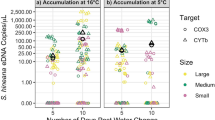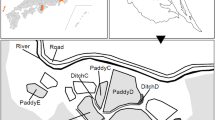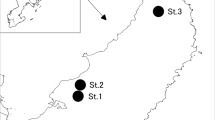Abstract
Sympetrum pedemontanum (Müller in Allioni) (Odonata: Libellulidae), which is distributed widely in the Eurasian continent and its neighboring islands, is listed as a Least Concern species in the International Union for Conservation of Nature Red List (2015). In Japan, however, the population of its subspecies S. pedemontanum elatum (Selys) has been rapidly decreasing since the 1970s. In order to conserve this subspecies, it is important to understand the seasonal microhabitat use by its larvae. However, this has been a difficult task because larvae of S. pedemontanum elatum often coexist with those of a common congener, S. eroticum (Selys), and cannot be morphologically distinguished from the latter. Thus, in this study, we first established a molecular technique based on the polymerase chain reaction to accurately identify each species. In the subsequent field survey in 2015 with its application in the Sakasegawa River, Hyogo Prefecture, we found that S. pedemontanum elatum larvae hatch in stagnant water and subsequently advance into weakly flowing water. Our results indicated a change in the microhabitats during the larval developmental process, reflecting the need for a continuous spectrum of stagnant, transitional, and flowing water. Such aquatic environments with a spectrum of water conditions are disappearing in Satoyama, a rural farming area in Japan. This has endangered species such as S. pedemontanum elatum and Oryzias latipes (Beloniformes: Adrianichthyidae) by depriving them of their favorable habitats. For their conservation, it is necessary to develop methods to recover the traditional aquatic environments in Satoyama.






Similar content being viewed by others
References
Adachi K, Kawata M, Tamamura K, Tamamura Y (2007) Mark-and-recapture survey of S. pedemontanum elatum. Kyousei-no-hiroba, MNHAH 2:62–66 (in Japanese)
Aoki T (1998) Odonata of Kobe. Kobe City Sports Education Association, Hyogo, p 155 (in Japanese)
Aoki (2013) Odonata of Kobe. http://www.odonata.jp/. Accessed 30 Nov 2015 (in Japanese)
Asami K, Nakao M, Akamatsu H, Tamura K (2001) A case study of vegetation management of abandoned rice fields for the conservation of water and wetland wildlife. J JILA 64:571–576 (in Japanese with an English summary)
Association of Wildlife Research and EnVision (2013) Search system of Japanese Red Data. http://www.jpnrdb.com/. Accessed 24 Oct 2015 (in Japanese)
Butler RG, Maynadier PG (2008) The significance of littoral and shoreline habitat integrity to the conservation of lacustrine damselflies (Odonata). J Insect Conserv 12:23–36
Corbet PS (1999) Dragonflies: behavior and ecology of Odonata. Cornell University Press, Ithaca, p 829
Duffy WG (1994) Demographics of Lestes disjunctus (Odonata: Zygoptera) in a riverine wetland. CJZ 72:910–917
Fox AD, Cham SA (1994) Status, habitat use and conservation of the scarce blue-tailed damselfly Ischnura pumilio (Charpenter) (Odonata: Coenagrionidae) in Britain and Ireland. Biol Conserv 68:115–122
Fujioka M, Lane SJ (1997) The impact of changing irrigation practices in rice fields on frog populations of the Kanto Plain, central Japan. Ecol Res 12:101–108
Fukuda S (2009) Consideration of fuzziness: is it necessary in modelling fish habitat preference of Japanese medaka (Oryzias latipes)? Ecol Mod 220:2877–2884
Futahashi R (2011) A revisional study of Japanese dragonflies based on DNA analysis (1). Tombo 53:67–74 (in Japanese with an English summary)
Hata K (1998) Influence of the paddy irrigation system on fishes habitation in Japan. J JSIDRE 66(2):143–148 (in Japanese)
Hata K (1999) Field experiment on the migration of fishes to an idle rice paddy with a small fishway. J JSIDRE 67(5):497–502 (in Japanese)
Hoogendoorn M, Heimpel GE (2001) PCR-based gut content analysis of insect predators: using ribosomal ITS-1 fragments from prey to estimate predation frequency. Mol Ecol 10:2059–2067
Ikeuchi K, Kanao K (2003) The approach and the issue to conservation and restoration for river environment in Japan. Ecol Civil Eng 5(2):205–216 (in Japanese with an English summary)
International Union for Conservation of Nature and Natural Resources (IUCN) (2015) The IUCN Red List of threatened species. http://www.iucnredlist.org/. Accesed 24 Oct 2015
Ishida S, Ishida K, Kojima K, Sugimura M (1988) Illustrated guide for identification of the Japanese Odonata. Tokai University Press, Tokyo, p 140 (in Japanese)
Ishii A, Sakuma T (2008) Actual conditions of irrigation facilities and their management for the conservation of rice terraces. Trans JSIDRE 253:79–84 (in Japanese with an English summary)
Itou M, Watanabe M, Watanabe E, Miura K (2013) Gut content analysis to study predatory efficacy of Nesidiocoris tenuis (Reuter) (Hemiptera: Miridae) by molecular methods. Entomol Sci 16:145–150
Johansson F, Suhling F (2004) Behavior and growth of dragonfly larvae along a permanent to temporary water habitat gradient. Ecol Entomo 29:196–202
Katano O, Hosoya K, Iguchi K, Aonuma Y (2001) Comparison of fish fauna among three types of rice fields in the Chikuma River basin. Jpn J Ichthyol 48:19–25 (in Japanese with an English summary)
Katoh K, Sakai S, Takahashi T (2009) Factors maintaining species diversity in satoyama, a traditional agricultural landscape of Japan. Biol Conserv 142:1930–1936
Kawachino Y (2015) Conservation status of 2014 of Sympetrum pedemontanum elatum (Selys). Trans Nagasaki Biol Soc 76:16–20 (in Japanese)
Kondo S, Tani K, Takazaki Y, Masuda Y (2005) Picture book of organisms in ponds and paddy fields. Tombo Press, Osaka, p 175 (in Japanese)
Lancaster J, Downes BJ (2013) Aquatic Entomology. Oxford University Press, Oxford, p 285
Lawton JH (1970) A population study on larvae of the damselfly Pyrrhosoma nymphula (Odonata: Zygoptera). Hydrobiologia 36:33–52
Maeto K, Kougo K, Kotani E, Miyata H, Sugimura M (2003) Geographical analysis of Odonata habitats in the Shimanto River Basin, Shikoku, Japan. Jpn J Ent (NS) 6:27–41 (in Japanese with an English summary)
Mukai Y, Baba N, Ishii M (2005) The water system of traditional rice paddies as an important habitat of the giant water bug, Lethocerus deyrollei (Heteroptera: Belostomatidae). J Insect Conserv 9:121–129
Muraki A (2010) Habitat environments of dragonflies. In: Inoue S, Miyatake Y (eds) Revision of How To Study Odonata. Japanese Society of Environmental Entomology and Zoology, Bunkyo Press, Osaka, pp 132–139 (in Japanese)
Nakajima M (1996) Sustainability of rice terraces. J Geogr 105:547–568 (in Japanese with an English summary)
New TR (1995) An introduction to invertebrate conservation biology. Oxford University Press, Oxford, p 194
Ozono A, Kawashima I, Futahashi R (2013) Dragonflies of Japan. Bun’ichi-Sogo Press, Tokyo, p 531 (in Japanese)
Palumbi S, Martin A, Romano A, McMillan WO, Stice L, Grabowski G (1991) The simple fool’s guide to PCR. Department of Zoology and Kewalo Marine Laboratory, University of Hawaii, Honolulu, p 47
Pierce CL (1988) Predator avoidance, microhabitat shift, and risk-sensitive foraging in larval dragonflies. Oecologia 77:81–90
Samways MJ (1994) Insect Conservation Biology. Chapman & Hall, London, p 358
Samways MJ, Steytler NS (1996) Dragonfly (Odonata) distribution patterns in urban and forest landscapes, and recommendations for riparian management. Biol Conserv 78:279–288
Schröter A (2010) The Odonata of Kyrgyzstan, part I—Critical national checklist, annotated list of records and collected data of the summer half-years 2008 and 2009. Int Dragonfly Fund 28:1–72
Sugimura M (1996) The Guide of Dragonfly Kingdom. Public Interest Incorporated Association of Dragonfly and Nature of Japan, Kochi Pref, pp 112 (in Japanese)
Tabuchi T, Suzuki S, Takamura Y (1983) Nitrogen removal in paddy fields during the non-ricegrowing period. Trans JSIDRE 104:9–15 (in Japanese with an English summary)
Tanaka M (1999) Influence of different aquatic habitats on distribution and population density of Misgurnus anguillicaudatus in paddy fields. Jpn J Ichthyol 46:75–81 (in Japanese with an English summary)
Wiley MJ, Kohler SL (1980) Positioning changes of mayfly nymphs due to behavioral regulation of oxygen consumption. Can J Zoolog 58:618–622
Yagi T, Adachi I, Miyoshi Y, Fujii M (2006) Sympetrum pedemontanum with immense companion. MNHAH, pp 64 (in Japanese)
Yoshikawa H (2006) The amenity of terraced paddy fields and policy measures for preservation. Sapporo Gakuin Law Rev 22(2):207–231 (in Japanese)
Acknowledgments
We thank Masato Ito for his assistance with collecting some of the Sympetrum species, and M. Takeda and K. Sakamoto (Kobe University) for permission to use their laboratory. We also thank Masaru Higashikawa, a member of the Water Administration Division of Takarazuka City, who collaborated with our investigation at the Sakasegawa River. This research was supported in part by JSPS KAKENHI Grant Number 25292034 to KM.
Author information
Authors and Affiliations
Corresponding author
Electronic supplementary material
Below is the link to the electronic supplementary material.
Rights and permissions
About this article
Cite this article
Higashikawa, W., Yoshimura, M., Yagi, T. et al. Microhabitat use by larvae of the endangered dragonfly Sympetrum pedemontanum elatum (Selys) in Japan. J Insect Conserv 20, 407–416 (2016). https://doi.org/10.1007/s10841-016-9874-x
Received:
Accepted:
Published:
Issue Date:
DOI: https://doi.org/10.1007/s10841-016-9874-x




